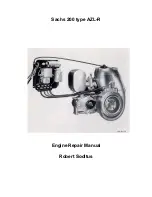
STORING YOUR ENGINE
- 17 -
7.
STORING ENGINE
Storage Preparation
Proper storage preparation is essential fo
r keeping your engine trouble free
and looking
good. The following steps will help to keep rust and corrosion from impairing your engine’s
function and appearance, and will make the engine easier to start after storage.
Cleaning
If the engine has been running, allow it to cool for at least half an hour before cleaning.
Clean all exterior surfaces, touch up any damaged paint, and coat other areas that may
rust with a light film of oil.
⚫
Using a garden hose or pressure washing equipment can force water into the
air cleaner or muffler opening. Water in the air cleaner will soak the air filter,
and water that passes through the air filter or muffler can enter the cylinder,
causing damage.
⚫
Water contacting a hot engine can cause damage. If the engine has been
running, allow it to cool for at least half an hour before washing.
Storage Precautions
1
、
DRAINING CARBURETOR
1)
、
Place a container underneath the carburetor, and use funnel for oil not spattering, close
fuel cock.
2
)
、
Remove the drain plug and sediment cup, then, open the fuel cock.
3
)
、
Immediately reassemble sediment cup and drain bolt after fuel completely draining.
And screw down.
Spring
Bolt







































